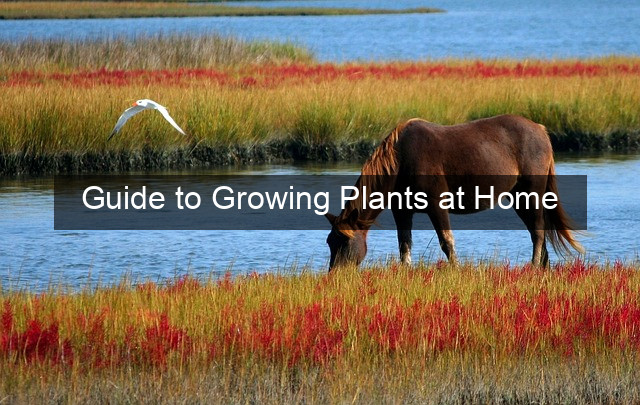Guide to Growing Plants at Home

- Guide to Growing Plants at Home
- A Comprehensive Guide to Growing Plants at Home
- Choosing the Right Plants
- Assessing Your Environment
- Matching Plants to Your Lifestyle
- Considering Plant Aesthetics
- Providing Optimal Care
- Watering Techniques
- Light Requirements
- Soil and Fertilization
- Dealing with Pests and Diseases
- Identifying Common Pests
- Preventing and Treating Diseases
- Maintaining Plant Hygiene
- Conclusion
- Frequently Asked Questions
- How often should I water my indoor plants?
- What are the best plants for beginners?
- How much light do indoor plants need?
- What type of soil should I use for indoor plants?
- How often should I fertilize my indoor plants?

A Comprehensive Guide to Growing Plants at Home
Imagine stepping into your home, greeted by the vibrant green of thriving plants, purifying the air and adding a touch of nature’s beauty to your living space. Growing plants at home offers a rewarding experience, connecting you with the natural world while enhancing your interior decor. Whether you’re a seasoned gardener or a complete beginner, this guide will equip you with the essential knowledge and practical tips to cultivate a flourishing indoor garden. From choosing the right plants to providing optimal care, we’ll explore every aspect of successful home gardening, empowering you to transform your home into a green oasis.
This journey begins with understanding the fundamental principles of plant care, including light, water, and soil requirements. We’ll delve into the nuances of different plant species, helping you select varieties that thrive in your specific environment. Furthermore, we’ll address common challenges like pests and diseases, providing effective solutions to ensure the health and longevity of your indoor plants. Growing plants successfully requires patience, dedication, and a genuine appreciation for the natural world. Join us as we unlock the secrets to creating a vibrant and thriving indoor garden.
Choosing the Right Plants
Assessing Your Environment
Before selecting your plants, carefully evaluate your home environment. Consider the amount of natural light available, the temperature fluctuations, and the humidity levels. South-facing windows receive the most sunlight, making them ideal for sun-loving plants. North-facing windows, on the other hand, receive less direct light and are suitable for shade-tolerant varieties. Understanding these factors will help you choose plants that are well-suited to your specific conditions.
Temperature and humidity also play a crucial role in plant growth. Some plants thrive in warmer temperatures, while others prefer cooler conditions. Similarly, some plants require high humidity, while others tolerate drier air. Researching the specific needs of each plant will ensure its successful growth in your home.
Finally, consider the available space in your home. Larger plants may require more room, while smaller plants can fit comfortably on shelves or windowsills. Choosing plants that are appropriately sized for your space will create a balanced and aesthetically pleasing indoor garden.
Matching Plants to Your Lifestyle
Your lifestyle also influences the types of plants that will thrive in your home. If you’re a busy individual with limited time for plant care, low-maintenance varieties like snake plants or ZZ plants are excellent choices. These plants can tolerate some neglect and still flourish.
If you enjoy the challenge of nurturing more demanding plants, orchids or ferns might be a good fit. These plants require more attention to detail, but the reward of their beautiful blooms and lush foliage is well worth the effort.
Ultimately, choosing plants that align with your lifestyle will increase your chances of success and ensure a long-lasting and enjoyable gardening experience.
Considering Plant Aesthetics
Beyond practical considerations, the aesthetic appeal of your plants is also important. Choose plants that complement your interior decor and personal style. Consider the color, texture, and shape of the leaves and flowers. Do you prefer vibrant blooms or subtle foliage? Do you want trailing plants or upright specimens?
Creating a visually appealing indoor garden can enhance the overall ambiance of your home. By carefully selecting plants that complement your existing decor, you can create a harmonious and inviting space.
Experiment with different plant combinations and arrangements to achieve the desired aesthetic. You can group plants together to create a lush, jungle-like feel or display individual plants as statement pieces. The possibilities are endless!
Providing Optimal Care
Watering Techniques
Proper watering is crucial for plant health. Overwatering can lead to root rot, while underwatering can cause the plant to wilt and die. The frequency of watering depends on the specific plant, the size of the pot, and the environmental conditions.
A good rule of thumb is to water the plant when the top inch of soil feels dry. Insert your finger into the soil to check the moisture level. If it feels dry, water the plant thoroughly until water drains from the drainage holes.
Avoid letting the plant sit in standing water, as this can lead to root rot. Ensure that the pot has drainage holes and empty any excess water from the saucer beneath the pot.
Light Requirements
Light is essential for photosynthesis, the process by which plants convert light energy into food. Different plants have different light requirements. Some plants require bright, direct light, while others prefer indirect or filtered light.
Observe your plants for signs of insufficient light, such as leggy growth or pale leaves. If your plants are not receiving enough light, you may need to move them to a brighter location or supplement with artificial light.
Similarly, too much direct sunlight can scorch the leaves of some plants. If you notice signs of sunburn, such as brown or crispy leaves, move the plant to a location with less intense light.
Soil and Fertilization
Using the right soil and providing adequate nutrients are essential for plant growth. Choose a well-draining potting mix that is specifically formulated for indoor plants.
Fertilize your plants regularly during the growing season, typically spring and summer. Use a balanced liquid fertilizer and follow the instructions on the label.
Avoid over-fertilizing, as this can damage the roots and harm the plant. It’s better to under-fertilize than to over-fertilize.
Dealing with Pests and Diseases
Identifying Common Pests
Indoor plants can be susceptible to various pests, such as spider mites, aphids, and mealybugs. Regularly inspect your plants for signs of pests, such as webbing, sticky residue, or small insects.
If you detect pests, take action immediately to prevent them from spreading. You can use natural methods like insecticidal soap or neem oil to control pests.
In severe cases, you may need to use a chemical pesticide. Follow the instructions on the label carefully and take precautions to protect yourself and your pets.
Preventing and Treating Diseases
Plant diseases can be caused by various factors, including fungi, bacteria, and viruses. Proper watering, adequate ventilation, and good sanitation practices can help prevent diseases.
If you notice signs of disease, such as wilting, discoloration, or spots on the leaves, isolate the affected plant to prevent the disease from spreading.
Treat the disease according to the specific pathogen involved. You can consult a local garden center or a plant expert for advice on appropriate treatments.
Maintaining Plant Hygiene
Maintaining good plant hygiene is essential for preventing pests and diseases. Regularly wipe the leaves of your plants with a damp cloth to remove dust and debris.
Remove any dead or decaying leaves and stems to prevent the growth of fungi and bacteria.
Clean and disinfect your gardening tools regularly to prevent the spread of diseases.
Conclusion
Growing plants at home is a fulfilling endeavor that brings nature’s beauty indoors. By understanding the fundamental principles of plant care and selecting plants suited to your environment and lifestyle, you can cultivate a thriving indoor garden. Remember that patience and observation are key. Each plant has unique needs, and learning to recognize those needs is crucial for their well-being. Don’t be discouraged by occasional setbacks. Even experienced gardeners face challenges. The joy of watching your plants flourish and enhance your living space makes the effort worthwhile.
Embrace the learning process and enjoy the journey of growing your own indoor oasis. With dedication and care, you can transform your home into a vibrant and verdant sanctuary. The rewards of growing plants extend beyond aesthetics, contributing to cleaner air and a greater connection with the natural world. So, embark on this enriching experience and discover the profound satisfaction of nurturing life within your own four walls.
Frequently Asked Questions
How often should I water my indoor plants?
Watering frequency depends on the plant type, pot size, and environment. Check the soil moisture regularly and water when the top inch feels dry.
What are the best plants for beginners?
Low-maintenance plants like snake plants, ZZ plants, and spider plants are great for beginners.
How much light do indoor plants need?
Light requirements vary depending on the plant. Observe your plants for signs of insufficient or excessive light and adjust their location accordingly.
What type of soil should I use for indoor plants?
Use a well-draining potting mix formulated for indoor plants.
How often should I fertilize my indoor plants?
Fertilize regularly during the growing season (spring and summer) using a balanced liquid fertilizer.



